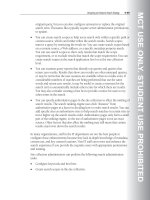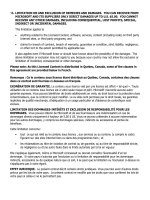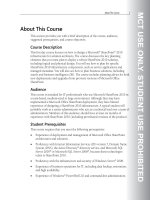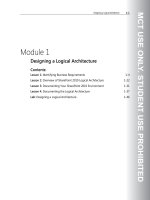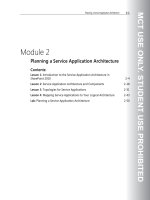Designing a Microsoft SharePoint 2010 Infrastructure Vol 1 part 8 docx
Bạn đang xem bản rút gọn của tài liệu. Xem và tải ngay bản đầy đủ của tài liệu tại đây (1.47 MB, 10 trang )
MCT USE ONLY. STUDENT USE PROHIBITED
1-40 Designing a Microsoft® SharePoint® 2010 Infrastructure
Using a Planning Worksheet
Key Points
One way to document the logical architecture design is by using a planning
worksheet. A planning worksheet provides a great deal of structured information
in a usable and concise format.
After you have identified the business requirements, you can map them onto the
seven columns in the planning worksheet:
• Business requirement. This column should always be the first documentation
element, because the logical design should always reflect business
requirements. You do not need to have a cell for each business requirement.
Rather, you must identify the requirements that will affect the number of Web
applications that you need to deploy.
• Site name. This column identifies the working name for each site. The top level
contains Web applications such as intranet, extranet, and Internet sites. Below
these, you have site collections, which house multiple sites below the site
collection. For example, you may have an intranet that provides sites for
departments in your organization, such as IT or HR. These are site collections
that will, in turn, host sites that are pertinent to these functional divisions.
MCT USE ONLY. STUDENT USE PROHIBITED
Designing a Logical Architecture 1-41
• Site URL. This column maps the URL and path for each site. The top level of
the farm contains root URLs (/) such as www.litwareinc.com for the Internet
site of Litware, Inc. Site collections in a Web application will have subsite
URLs. For example, an intranet site may include a site collection (/sites), in
which there are subsites, such as /sites/IT for the IT division or /sites/HR for
the HR division.
• Parent site. This column identifies each of the Web applications in which all
other sites exist. In the Litware, Inc. example, this may include Internet
(www.litwareinc.com), intranet (intranet.litwareinc.com), or extranet
(extranet.litwareinc.com) parent sites. Remember that My Sites should have its
own Web application for performance and management reasons, such as
my.litwareinc.com.
• Template. This column specifies the site template that is best suited to create
the Web application, site collection, or site. The site templates provide core
functionality that is appropriate to your site.
• Content database name. This column links the sites to content databases. These
may be shared or used for specific secured or volume data. In your design, you
should identify logical database divisions, such as Internet and intranet.
However, you should also identify the software boundary limitations of
databases so that you offer additional databases for large document storage
environments. Remember that site collections cannot span content databases,
so you must design for scalability.
• Notes. This column is for notes that explain the rationale or specific
functionality associated with each site. Your design documentation is not like
process documentation, where you list a series of steps that are the only way to
complete a task. You should include justification notes to explain the logic
behind your decisions, which will help you later when your design focuses on
individual components of your deployment.
MCT USE ONLY. STUDENT USE PROHIBITED
1-42 Designing a Microsoft® SharePoint® 2010 Infrastructure
Sample Scenario: Identifying Business Requirements
Key Points
The slide displays a well-structured requirements document that contains a lot of
information regarding your user requirements. As a designer, you must review this
to identify the components that will influence and drive your SharePoint design. It
is usually easy to locate volume information such as the number of users, sites, or
data volumes. You should also be able to find less metric-based information.
You can see from the highlighted elements of this slide that there is a lot of
information that should affect your design. As an approach, highlighting elements
that you think will influence logical architecture design is very useful. It maintains
the integrity of the document, so that you do not unwittingly change the
requirements, while identifying the key components. You may choose to use
various highlighting colors or add comments to categorize these elements.
MCT USE ONLY. STUDENT USE PROHIBITED
Designing a Logical Architecture 1-43
Sample Scenario: Mapping Business Requirements to
Logical Architecture
Key Points
Mapping your business requirements to a planning worksheet helps you map the
logical components of your design. There is a range of business requirements that
you can identify from this short document and map to the Logical Architecture
Planning Worksheet.
Worksheet Columns
1. The required departmental intranet sites. The Litware, Inc. site requires divisional
sites (implemented as site collections) for each of the six departments. Each
site collection is based on a publishing template because the intention is for
the departments to publish internal information.
2. The required Internet-facing site and its products subsite. Litware, Inc. requires an
Internet site that can show all product information, so you should use a
dedicated Web application. This will almost certainly require anonymous
access for casual browsers. It is also likely that the Litware, Inc. Internet site
MCT USE ONLY. STUDENT USE PROHIBITED
1-44 Designing a Microsoft® SharePoint® 2010 Infrastructure
will require other components to be published, such as About Us information,
for example.
3. The extranet site and subsites for partners. There is a business requirement for
extranet access to partners, in addition to sites for each partner. In this case,
there is a site collection called /partners below which each individual partner
site can be hosted.
4. The My Sites requirement. The requirements specifically state that there is a
desire to start using social computing to aid communications in the
organization through the availability of personal Web sites. This means that
you will need a My Sites Web application. For security, capacity, and
performance reasons, it is good practice to dedicate a Web application to My
Sites. This will also influence the physical design because you should keep
your Active Directory® directory service server local to maximize performance.
There is no specification that Litware, Inc. is a multinational organization, but
you should check. In the notes, you can see that there is no specification for
self-service site provision. As a designer, you should check this because it
would have a major impact on IT administration. Each My Site is a site
collection, so you can estimate the number of My Sites. This will influence the
volume of content and therefore any quotas that you may set on personal sites.
MCT USE ONLY. STUDENT USE PROHIBITED
Designing a Logical Architecture 1-45
Using a Visio Diagram
Key Points
The use of Microsoft Visio® diagrams can provide a visual representation that will
augment information in a spreadsheet or report table. This form of documentation
is popular because it provides a summarized structure that is easy to consume. The
graphical elements make it easier to identify each logical component in the
SharePoint logical architecture. Diagrams should be kept simple and provide a
high-level summary of the design.
By using both tabular and diagrammatic documentation, you can deliver a
documented design that is both easy for business and IT users to visualize, and
contains all of the information that you require to influence detailed design for
physical or other planning.
MCT USE ONLY. STUDENT USE PROHIBITED
1-46 Designing a Microsoft® SharePoint® 2010 Infrastructure
Lab: Designing a Logical Architecture
Exercise 1: Mapping Business Requirements to a Logical
Architecture Design
Scenario
Central IT at Contoso, Ltd has completed the business requirements gathering and
the stakeholders have approved its findings. Central IT has tasked your team with
creating a logical architecture design that addresses these requirements.
The information that your team has gathered is detailed in the supplied
documents. Use these documents to produce your logical design.
The main tasks for this exercise are as follows:
1. Read the supporting information.
2. Complete the Logical Architecture Planning worksheet.
MCT USE ONLY. STUDENT USE PROHIBITED
Designing a Logical Architecture 1-47
f Task 1: Read the supporting information
1. Log on to 10231A-NYC-DC1-01 as CONTOSO\Ed with the password
Pa$$w0rd.
2. Read the lab scenario.
3. In the E:\Labfiles\Lab01\Starter folder, read the information in the Contoso
Business Requirements.docx file.
4. In the E:\Labfiles\Lab01\Starter folder, read the information in the Logical
Architecture Requirements.docx file.
f Task 2: Complete the Logical Architecture Planning worksheet
• In the E:\Labfiles\Lab01\Starter folder, complete the worksheet in the Logical
Architecture Planning Worksheet.xlsx file.
Exercise 2: Creating a Logical Architecture Diagram
Scenario
You need to create a graphical summary of the content in the completed logical
architecture worksheet.
The main task for this exercise is to complete a logical architecture diagram.
f Task 1: Complete a logical architecture diagram
• In the E:\Labfiles\Lab01\Starter folder, complete the diagram in the Logical
Architecture Diagram.vsd file.
MCT USE ONLY. STUDENT USE PROHIBITED
1-48 Designing a Microsoft® SharePoint® 2010 Infrastructure
Module Review and Takeaways
Review Questions
1. What are the key differences between functional and nonfunctional
requirements?
2. Outline the essential things that you should do when gathering user
information.
3. Which are the key components of your logical design that you should
document in a Logical Architecture Planning Worksheet?
Best Practices Related to Creating a Logical Architecture Design
Supplement or modify the following best practices for your own work situations:
• When you are designing a SharePoint 2010 solution, it is essential to map
business requirements to a logical architecture design before you start to
deploy.
MCT USE ONLY. STUDENT USE PROHIBITED
Designing a Logical Architecture 1-49
• Always validate your design with your stakeholders. This ensures that you fully
reflect their business goals and they understand your design functionality.
• Always update changes to your documentation.
